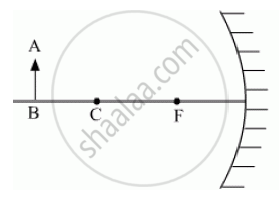Advertisements
Advertisements
Question
A convex lens of focal length 25 cm is placed coaxially in contact with a concave lens of focal length 20 cm. Determine the power of the combination. Will the system be converging or diverging in nature?
Solution
We have focal length of convex lens,
lens, f2 =-20 cm =-0.20 m
Equivalent focal length,
∴ F =- 100 cm
Power of convex lens,
Power of convex lens,
Power of the combination,
The focal length of the combination =–1 m = –100 cm.
As the focal length is in negative, the system will be diverging in nature.
APPEARS IN
RELATED QUESTIONS
Suppose the lower half of the concave mirror's reflecting surface is covered with an opaque material. What effect this will have on the image of the object? Explain
A convex lens of focal length 20 cm is placed coaxially with a convex mirror of radius of curvature 20 cm. The two are kept 15 cm apart. A point object is placed 40 cm in front of the convex lens. Find the position of the image formed by this combination. Draw the ray diagram showing the image formation.
Draw a ray diagram to show image formation when the concave mirror produces a real, inverted and magnified image of the object.
Obtain the mirror formula and write the expression for the linear magnification.
A convex lens of focal length 20 cm is placed coaxially in contact with a concave lens of focal length 25 cm. Determine the power of the combination. Will the system be converging or diverging in nature?
A convex lens of focal length 30 cm is placed coaxially in contact with a concave lens of focal length 40 cm. Determine the power of the combination. Will the system be converging or diverging in nature?
An object AB is kept in front of a concave mirror as shown in the figure.

(i) Complete the ray diagram showing the image formation of the object.
(ii) How will the position and intensity of the image be affected if the lower half of the mirror’s reflecting surface is painted black?
The convex surface of a thin concavo-convex lens of glass of refractive index 1.5 has a radius of curvature 20 cm. The concave surface has a radius of curvature 60 cm. The convex side is silvered and placed on a horizontal surface as shown in figure. (a) Where should a pin be placed on the axis so that its image is formed at the same place? (b) If the concave part is filled with water (μ = 4/3), find the distance through which the pin should be moved so that the image of the pin again coincides with the pin.

A particle is moving at a constant speed V from a large distance towards a concave mirror of radius R along its principal axis. Find the speed of the image formed by the mirror as a function of the distance x of the particle from the mirror.
A gun of mass M fires a bullet of mass m with a horizontal speed V. The gun is fitted with a concave mirror of focal length f facing towards the receding bullet. Find the speed of separation of the bullet and the image just after the gun was fired.
